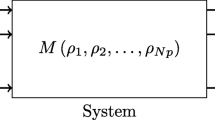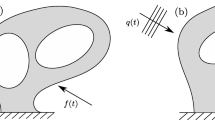Abstract
Inverse scattering acoustics find practical applications in the detection and imaging of objects embedded in continuous media as well as in finding the optimum geometric configuration of an object to produce a given radiation performance. This work introduces a boundary element method (BEM) approach for the solution of acoustic identification and optimization problems via a topological-shape sensitivity method. The devised optimization tool takes advantage of the inherent characteristics of BEM to effectively solve the forward and adjoint acoustic problems arising in the topological derivative formulation and to deal with infinite domains. The objectives for the identification and optimization problems are to achieve a prescribed sound pressure at a given region of the problem domain. The locus giving extreme values for the topological derivative indicates the optimum positions for the placement of sound-hard scatterers in order to minimize the cost function. The proposed implementation has the ability to deal with initially empty design spaces as well as with design spaces containing pre-existent scatterers. The capabilities of the method are demonstrated by solving a number of identification and optimization problems.












Similar content being viewed by others
References
Abe K, Fujiu T, Koro K (2010) A BE-based shape optimization method enhanced by topological derivative for sound scattering problems. Eng Anal Bound Elem 34(12):1082–1091. doi:10.1016/j.enganabound.2010.06.017
Anflor CTM, Marczak RJ (2009) A boundary element approach for topology design in diffusive problems containing heat sources. Int J Heat Mass Transf 52(19–20):4604–4611. doi:10.1016/j.ijheatmasstransfer.2009.02.048
Bertsch C, Cisilino AP, Calvo N (2010) Topology optimization of 3D elastic structures using boundary elements and the topological derivative. Adv Eng Softw 41:694–704
Bonnet M, Constantinescu A (2005) Inverse problems in elasticity. Inverse Probl 21:R1–R50
Bonnet M (2006) Topological sensitivity for 3D elastodynamic and acoustic inverse scattering in the time domain. Comput Methods Appl Mech Eng 195:5239–5254
Brancati A, Aliabadi MH, Mallardo V (2012) A BEM sensitivity formulation for three-dimensional active noise control. Int J Numer Methods Eng 90(9):1183–1206
Brebbia CA, Telles JCF, Wrobel LC (1984) Boundary element techniques: theory and applications in engineering. Springer Verlag, Berlin
Carpio A, Rapún ML (2008) Topological derivatives for shape reconstruction. Inverse Probl Imagining 1943:85–133
Carretero Neches L, Cisilino AP (2008) Topology optimization of 2D elastic structures using boundary elements. Eng Anal Bound Elem 32(7):533–544. doi:10.1016/j.enganabound.2007.10.003
Cisilino AP (2006) Topology optimization of 2D potential problems using boundary elements. Comput Model Eng Sci 15(2):99–106
Colton D (1984) The inverse scattering problem for time-harmonic acoustic waves. SIAM Rev 26:323–350
Devaney AJ (1984) Geophysical diffraction tomography. IEEE Trans Geosci Remote Sens 22:3–13
Dorn O, Lesselier D (2006) Level set methods for inverse scattering. Inverse Probl 22:R67
Eschenauer HA, Kobelev VV, Schumacher A (1994) Bubble method for topology and shape optimization of structures. Struct Optim 8:42–51
Feijóo GR (2004a) A new method in inverse scattering based on the topological derivative. Inverse Probl 20(6):1819–1840. doi:10.1088/0266-5611/20/6/008
Feijóo GR, Oberai AA, Pinsky PM (2004b) An application of shape optimization in the solution of inverse acoustic scattering problems. Inverse Probl 20:199–228
Goncharsky AV, Romanov SY (2013) Supercomputer technologies in inverse problems of ultrasound tomography. Inverse Probl 29(7):075004. doi:10.1088/0266-5611/29/7/075004
Kleinman RE, van den Berg PM (1992) A modified gradient-method for two-dimensional problems in tomography. J Comput Appl Math 42:17–35
Liseno A, Pierri R (2004) Imaging of voids by means of a physical optics based shape reconstruction algorithm. J Opt Soc Am A 21:968–974
Marczak RJ (2007) Topology optimization and boundary elements—a preliminary implementation for linear heat transfer. Eng Anal Bound Elem 31(9):793–802
Marczak RJ (2008) Optimization of elastic structures using boundary elements and a topological-shape sensitivity formulation. Latin Am J Solids Struct 5:99–117
Natterer F, Wübbeling F (1995) A propagation backpropagation method for ultrasound tomography. Inverse Probl 11:1225–1232
Nemitz N, Bonnet M (2008) Topological sensitivity and FMM-accelerated BEM applied to 3D acoustic inverse scattering. Eng Anal Bound Elem 32(11):957–970. doi:10.1016/j.enganabound.2007.02.006
Novotny AA, Feijóo RA, Taroco E, Padra C (2003) Topological sensitivity analysis. Comput Methods Appl Mech Eng 192(7–8):803–829. doi:10.1016/S0045-7825(02)00599-6
Pereira AMB, Noronha MAM (2009) Post-processing and visualization techniques in 2D boundary element analysis. Eng Comput 26(1):35–47. doi:10.1007/s00366-009-0134-5
Wrobel LC (2002) The boundary element method: applications in thermo-fluids and acoustics. John Wiley and Sons, Hoboken
Acknowledgments
This work has been supported by grants DA0806 of the Ministry of Science and Technology of Argentina and the Deutscher Akademischer Austauschdienst of Germany, PIRSES-GA2009_246977 “Numerical Simulation in Technical Sciences” of the European Union and PICT (2011) No. 159 “Modeling of functional and intelligent materials and structures” of the Ministry of Science and Technology of Argentina. The authors acknowledge valuable comments by the reviewers that contributed to improve the quality of the manuscript.
Author information
Authors and Affiliations
Corresponding author
Rights and permissions
About this article
Cite this article
Sisamón, A.E., Beck, S.C., Langer, S.C. et al. Inverse scattering analysis in acoustics via the BEM and the topological-shape sensitivity method. Comput Mech 54, 1073–1087 (2014). https://doi.org/10.1007/s00466-014-1051-z
Received:
Accepted:
Published:
Issue Date:
DOI: https://doi.org/10.1007/s00466-014-1051-z




